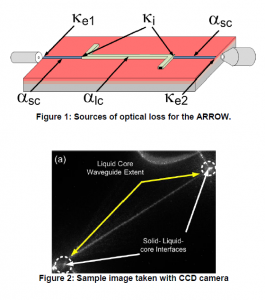Micah Jenkins and Dr. Aaron Hawkins, Department of Electrical and Computer Engineering
One exciting field of research within optics involves using on chip optical waveguides as biological sensors. Dr. Aaron Hawkins and his team of students have worked to develop a platform for bio-sensing using ARROW’s (anti-resonant reflecting optical waveguides) to confine light to a hollow core channel. These devices are filled with sample solutions and can be used to detect changes in optical transmission as fluorescently tagged particles traverse the hollow core channel.
The goal of this research is to design and fabricate the ARROW devices to maximize the overall optical throughput. There are a number of factors that cause signal loss in the ARROW including waveguide attenuations and coupling efficiencies. (Fig. 1, Eq. 1)
In order to maximize the optical performance of the ARROW we needed a way to characterize these optical losses. Because we were the first to fabricate such devices there was no established method of optical measurement available. My project was to implement such a method for characterizing the optical performance of these devices using scattered light imaging.
The procedure for measuring attenuation loss in waveguides using the light scattering method is relatively simple. First, the sample is set on 3D translation stage next to a bare optical fiber so that light can be coupled into the waveguide following alignment. A 633 nm (red light) source is used to couple optical power through to the tip of the fiber. Using a free standing microscope, the sample is then aligned to the fiber using the 3D translation stage until the tip of the optical fiber next to the waveguide entrance. For quality waveguide cleaves, up to 95% of the incident light can be coupled into the waveguide.
After light has been coupled into the waveguide, the waveguide then illuminates along its longitudinal direction due to surface scattering. Waveguide attenuation losses are due to two primary causes, which are surface scattering due to roughness and material absorption. The central assumption made in this method for loss measurement is that the light which scatters out of the waveguide will be directly proportional to the amount of optical power in the waveguide at the point from which it scatters. Under this assumption, a CCD camera can be used to image the illuminated waveguide thereby collecting information about how the power in the waveguide varies longitudinally.
Following sample imaging (see Fig. 2 for a sample image), software tools such as the image processing toolbox on MATLAB can be used to rotate and crop the image, as well as integrate the pixel intensities in the longitudinal direction. MATLAB can also be used to take the logarithm of the measured data and perform least squares fitting to calculate the attenuation loss for a particular image.
Over the course of time that I worked on this project, we were able to build the experimental setup required for this measurement and work through all of the challenges associated with this method. I was published in Optics Communications for an article which describes and advocates this technique as an attractive approach for the optical characterization of optofluidic waveguides in general. The method is cited in four other academic papers as a way of determining waveguide loss. A detailed document containing procedures for carrying out this measurement was written, and this measurement is still being performed to help Dr. Hawkins’ team improve their devices.
Overall, this was an invaluable learning experience for me. I have just graduated and am beginning my first year as a Ph.D. student at Georgia Institute of Technology, where I will work on a project involving the use of imaging as a means of characterizing optical fibers. I know that my research at BYU will help me with my new research project. The mentoring experience prepared me professionally and encouraged me to consider careers performing research at national laboratories. This project not only provided useful information to the field of optics, but helped me become more certain about my career path.

